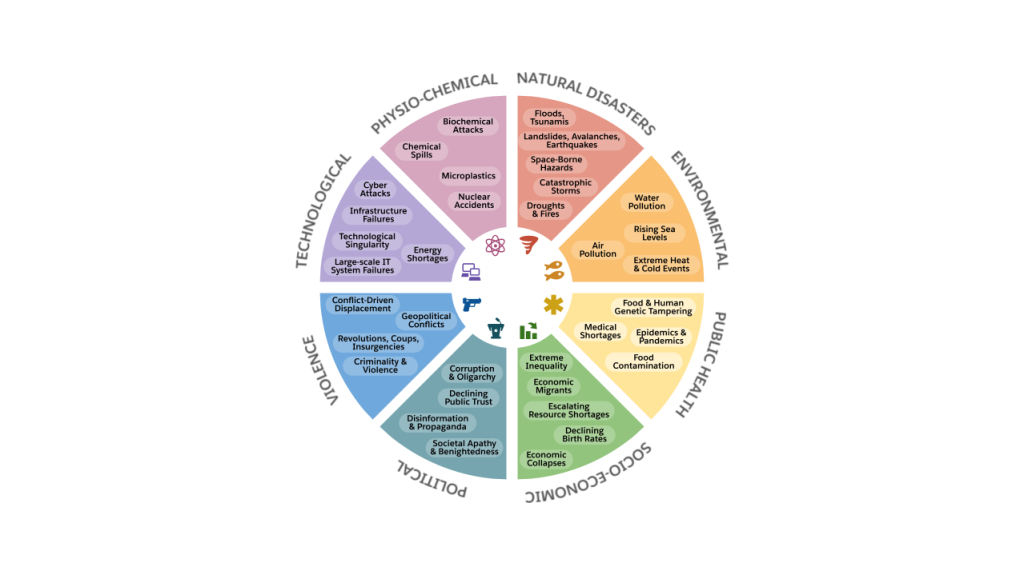Emergency Readiness – A Resilient Operating Model for Local Government



Emergencies are more frequent and severe, prompting local governments to update their operating models and tech architectures to manage risks.


Catastrophes — both natural and human-induced — are increasingly common across Europe and the world, driven by factors such as climate change and geopolitical tensions. While there is a wealth of European, national, and regional legislation and frameworks in place, cities in particular (being the first line of response) are often ill-prepared. Levelling up the readiness for worst-case scenarios requires cities both to rethink their governance models and processes, as well as to modernise the underlying technology infrastructure.
Increasing frequency and magnitude
Emergency events are projected to increase both in frequency and magnitude over the coming years. Climate change is a key driver, contributing to extreme weather events such as heat waves and heavy storms. Worldwide, natural disasters in 2023 led to more deaths than in any previous year, with recorded global financial losses of around $250 billion.

According to C40 analyses, urban areas tend to be particularly affected and at risk. For example, floods in urban areas are expected to cost $64 billion per year by 2050, even with current levels of global flood protection in place. While most of the negative effects of natural disasters are immediate (e.g. damage to houses and infrastructure), long-term effects (e.g. on employment and health) exacerbate the situation. Next to weather-related disasters, the rate and impact of other types of crises should not be underestimated. These include pandemics, food safety, conflicts and terror events, nuclear accidents, and increasingly those in the digital space, such as cyber-attacks and disinformation campaigns.
The complexity of managing emergencies
Apart from the increasing frequency and magnitude, the intrinsic complexity of emergency events makes them even more difficult to address. While competencies lie primarily with the cities affected, events often affect even multiple countries. For instance, a flooding river that transcends sub-national and national boundaries would require close coordination between many jurisdictions and different levels of government, not to mention NGOs and private sector organisations.
The European legal framework has evolved into a complex structure with competencies and responsibilities spread across global, European, national, and regional levels, making coordination vital, but often difficult to realise. As illustrated in the diagram below, most cities in Europe maintain a dedicated emergency response team, which has to coordinate with at least seven different stakeholder categories, each of which can comprise multiple disparate entities. Activities that require close coordination include:
- Informing and updating the public
- Identifying, compiling, triaging, and actioning issues (e.g. closing roads)
- Shift scheduling for task force members (potentially including auxiliaries and/or citizen volunteers)
- Mobilising equipment, assets, and resources
- Distributing short-term funds (and later, recovery funds)
- Arranging housing and care for displaced citizens
As it often comes with complex and dispersed levels of competence, when emergencies hit, operations are chaotic, marked by uncertainty about competencies and responsibilities. Take for example the severe flooding in the Ahr Valley in Germany in July 2021 which led to 184 deaths. While the force of nature was in many ways unprecedented, experts claim that severe shortcomings in the government’s emergency planning along the entire value chain further amplified the impact of the situation. Weather forecasts ahead of the flooding were not properly assessed and not communicated to citizens; alarm chains and communications during the flood failed; important equipment was missing, and no inventory existed. Many of these could have been prevented with a more structured approach not only during but also in the phases before and after the flooding.
Towards a new resilient operating model for cities
Improving cities’ readiness for worst-case scenarios requires a new operating model across all stages of the emergency preparedness and response life cycle. The European Union has identified five different stages: Anticipate, Prepare, Alert, Respond, and Secure, which we amended to also account for the phases before (including prevention) and after (including recovery) the emergency event:
- Prevent, Mitigate & Anticipate: Taking actions to reduce the likelihood of incidents occurring in the first place — or at least reducing their impact — as well as improving risk assessment and disaster management planning.
- Prepare: Increasing risk awareness and preparedness of the population as well as adequate and regular training of response teams.
- Alert, Respond & Secure: Alerting the population, responding and coordinating during the emergency event, and securing people and assets.
- Recovery: To ensure a robust civil protection system, it is important to consider post-incident recovery as part of the process.
Stakeholders fall into three primary categories, each with distinct needs and priorities across the crisis lifecycle:
- Citizens (potentially) affected by the emergency event need timely, accurate information and instructions, along with rescue or security services, supplies, accommodation, and easy access to support and recovery funds.
- Emergency Response Centres handle the management of supply inventories, assets, personnel, and other resources. They also oversee communication, risk assessment, and strategic planning.
- A Task Force, which relies heavily on intelligence and other information from the response centre, and provides first-hand support on the ground. Task force members must also coordinate among themselves to execute their missions effectively and efficiently.
The image below represents a potential framework of key capabilities that local authorities possess throughout the five stages of the emergency response life cycle. This representation is a non-exhaustive list and can vary from country to country, based on the distribution of responsibilities among different levels of government. The model might also differ from one city to another within the same country, influenced by factors such as city size or specific public-private partnership models. Nevertheless, it is critical to address all of these capability areas, regardless of the distribution of roles and responsibilities. To develop a new resilient operating model, cities are encouraged to start the process by defining their own target operating model, identifying gaps and bottlenecks, and producing a transformation plan to incrementally move towards this desired future state.
After mapping capabilities, it is essential for cities to put the right technology foundation in place. Oftentimes, cities’ emergency management capabilities are siloed and fragmented. This limits their ability to coordinate and execute quickly and effectively, and even worse, can lead to critical data being missed or delayed during the crisis. When updating the underlying technology infrastructure, a platform approach addresses many of these challenges, increasing cities’ resilience and response posture. Adequate platforms for emergency response need to bring integrated capabilities, including:
- Multi-channel cooperation across stakeholders: Communication and coordination are key to the entire emergency response life cycle. On the one hand, response teams have to exchange information between each and supporting partners (such as other levels of government, NGOs or commercial entities) via different tools such as chat, telephone, and email. For example, the U.S. National Weather Service has developed NWSChat via Slack to expand its ability to communicate weather observations and forecast information with emergency managers and other core partners. On the other hand, communication also includes broadcasting efforts to citizens via SMS, alert systems like EU-Alert as well as via websites. It is important that broadcasted information is reliable, up-to-date, and easily accessible to everyone. For example, during the Covid lockdown, the local authorities of Larimer County decided to publish Covid-related statistics on their website to make sure citizens were informed about the latest developments in the pandemic.
- Relationship/inventory management: Especially due to the complex governance structure in emergency situations, it is important that assets, resources, locations, relationships, etc. are tracked and mapped in real-time. For instance, in 2020 Ireland’s Health Service Executive (HSE) launched COVAX, a nationwide vaccine management platform to track inventories and demand for vaccines and other health-related supplies across Ireland. With COVAX, the government ensured that supplies were available where they were needed the most.
- Integration: Proprietary systems and standard data sources need to be connected securely and easily across a diverse system landscape, to ensure critical information is available.
- Data visualisation: Data assessment and visualisation is needed throughout various stages. For example, emergency response teams can use visualisations to understand which parts of cities will be most impacted by disaster events, and overlay impacted areas with the availability of necessary equipment to highlight risks and gaps. Data visualisations can also help in depicting trends and developments in the likelihood of disasters occurring so that relevant precautions can be taken. For instance, the European Environment Agency (EEA) embeds easily accessible Tableau dashboards into their external-facing web portal to help policy-makers and other relevant stakeholders make important climate-related decisions.
- Automation and artificial intelligence: In preparing, managing, and offsetting emergencies, efficiency and speed are essential. The ability to automate processes (including on-the-fly as the crisis unfolds) is critical. For instance, during the recovery stage, requesting recovery funds is often cumbersome and time-consuming, both to set up the scheme and administer it. With automation and AI, these processes can become leaner and more efficient, quickly delivering crucial support to those affected. For instance, in 2020 Bushfire Recovery Victoria (BRV) set up the MyRecovery Portal, which provides affected citizens with recovery services online. Through automation, the portal offers a service experience targeting culturally and linguistically diverse people. Another stage where automation and AI are beneficial is when it comes to coordination efforts of a large workforce composed of volunteers. The Red Cross has recently automated outreach and communication with volunteers during the Ukraine crisis, leading to better coordination and time savings.
- Pre-built, composable platforms: Although emergency management frameworks tend to be similar, there are certain elements where customisation is useful. This may be the case because of a specific governance structure or because different types of emergencies require different remedies. Opting for platforms that are foundationally low-code or no-code means that enhancements are possible without extensive IT know-how, and even without prior knowledge.
Emergency response platforms must not only support a variety of capabilities but also be quick to implement and easy for all staff to use, regardless of their tech skills. In emergencies, additional resources from diverse backgrounds will need to assist response teams. Thus, it is crucial that everyone, regardless of their IT skills levels, can quickly start using the platform and conduct self-service learning modules.
Getting started—incremental improvements deliver rapid, material benefits
With the obvious advantages of a platform approach, the question remains on how to turn ambitions into practice. Many transformation efforts fail in practice because it is difficult to know where to start. There are a few success criteria in the public sector, such as identifying funding streams early on, executing with the right methodology, and partnering with the right stakeholders.
With ever tighter budgets and increasing obligations, local authorities are unable to adequately fund each of their priorities, frequently at the expense of resilience and preparedness.1 However, cities can get ahead of the curve even in austere times. For example, European Union financing schemes such as sectoral funds on climate change or structural and investment funds offer not only budgetary support but also expert advice (on digitalisation and project management).2
In terms of execution, it is important to have a long-term vision but focus on succeeding with smaller milestones. In practice, this means that rather than attempting to address the entire emergency response life cycle at once, transformation leaders should break up the problem into more manageable pieces, and approach them incrementally. There are many methodologies and principles to follow and help with identifying the right milestones for the short and long run.
Finally, partnering is a vital element of the transformation journey. Identifying the right technology partner is as relevant as having access to the right expertise on the implementation side. Ultimately, regular exchange with like-minded organisations on lessons learned and best practices is key to achieving a successful outcome.
1 Most often governments are reactive when it comes to disaster management and resilience. For example, in the Ahr valley tragedy important reforms and budgets were only made available after the event.
2 Sectoral funds (such as Horizon Europe, LIFE, URBACT) or Structural and investment funds (such as European Commission Technical Support Instrument (TSI)).






